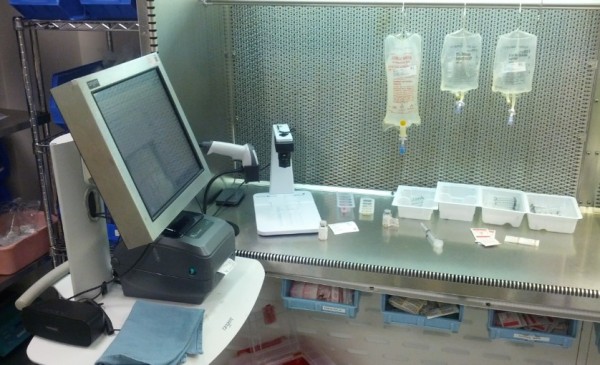Summary: if you’re preparing compounded sterile preparations (CSPs) in a pharmacy IV room, you should be using gravimetric analysis to determine the appropriate dose/volume.
Pharmacy practice is easy. Our job is to provide the right drug, at the right dose, to the right patient in the safest, most efficient, cost-effective manner possible. Simple.
Currently, the only method for ensuring that the correct drug is used during sterile compounding is barcode scanning. The future may hold other methods — I’ve read promising things about real-time solution concentration and drug identification using Raman spectroscopy — but for now, barcode scanning is it.
There are three basic methods for ensuring the correct dose/volume: traditional volumetrics using the pull-back method or using a pharmacist step-check process; photo-assisted volumetrics where the pharmacist views a photo of the drug drawn up in the syringe (1); and gravimetrics.(2)

Figure 1 from Terkola et al. J Clin Pharm Ther. 2017
The Volumetric method is limited by human error. In a situation where the pharmacy utilizes the pull-back method, there’s nothing to prevent a wrong dose from accidentally being injected into a bag only to have the technician pull the empty syringe back to the correct volume. The pull-back method of IV preparation is universally panned by organizations like ASHP and ISMP. Any pharmacy still using the pull-back method to prepare CSPs should be considered criminally reckless as they are endangering the lives of their patients every time they make an IV. It is unconscionable to be using the pull-back method for IV preparation in this day and age.(3)
Using either a step-check process or photo-assisted volumetrics is significantly better than the pull-back method, but not without their pitfalls. I’ve seen errors resulting from both methods where the technician pulled the wrong dose and the pharmacist verified it. It is unclear how this happens. It may result from checking bias, simple “slips”, or even laziness on the part of the pharmacist. It’s difficult to know for certain.
Gravimetric analysis utilizes the specific gravity of a solution to quantitatively determine the analyte, i.e. the drug found in the solution. In the case of an i.v. preparation, the method can be used to determine the accuracy of a dose drawn into a syringe, removed from a vial, injected into an i.v. bag, and so on. The assumption is that if you know the weight of an object – syringe, i.v. bag, a vial of medication, etc – before and after adding or removing a substance, then you know exactly how much drug was added or removed.
Gravimetrics acts as a forcing function, i.e. you can’t continue the compounding process until you have the correct weight. It’s also incredibly accurate. The only thing I’m uncertain about at this moment is how low the weight can be and still be accurate. This is important as small volumes in small syringes can be problematic.
Overall, syringes as a measuring device are accurate, but variable.(4) Tolerances for sterile graduated plastic single-use hypodermic syringes are defined by the International Organization for Standardization (ISO), specifically ISO 7886-1. ISO standards vary by syringe size and volume of fluid drawn and expelled. The commonly accepted definition for an accurate disposable syringe below 5 mL nominal capacity is +/-Â 5% when measuring volumes at or above 50% nominal volume. Accuracy increases slightly to +/- 4% when measuring volumes at or above 50% nominal volume for syringes greater than 5mL nominal capacity.

Figure 2 from Terkola et al. J Clin Pharm Ther. 2017
There are several semi-automated IV workflow management systems available today. They range from low-end, lightweight systems to high-end, feature robust systems. Pick your poison, as they say. However, I encourage anyone looking for one of these systems to give serious consideration to those that offers a fully integrated scale, i.e. gravimetrics. Doing otherwise could potentially be tragic.

Left to right: i.v.SOFT from Omnicell, BD Cato from BD, DoseEdge from Baxter. Image Source: Jerry Fahrni, Pharm.D.
—————————————
- The photo can be viewed before or after the drug is shot into the final container, depending on the workflow. Obviously, viewing a photo of a syringe containing drug after the CSP has been made has its limitations.
- The image does a good job of showing the difference between volumetric and gravimetric preparation. Source: Terkola R, Czejka M, Bérubé J. Evaluation of real-time data obtained from gravimetric preparation of antineoplastic agents shows medication errors with possible critical therapeutic impact: Results of a large-scale, multicentre, multinational, retrospective study. Journal of Clinical Pharmacy and Therapeutics. 2017. doi:10.1111/jcpt.12529.
- I’m of the opinion that state boards of pharmacy should begin fining pharmacies that still use the pull-back method for IV prep. Administrators should be held professionally and personally responsible for allowing the method to continue. It simply shouldn’t be allowed. It’s dangerous, reckless, and lazy.
- Poppe L, Savage S, Eckel S. Assessment of final product dosing accuracy when using volumetric technique in the preparation of chemotherapy. Journal of Oncology Pharmacy Practice. 2016;22(1):3-9. doi:10.1177/1078155214549489.


